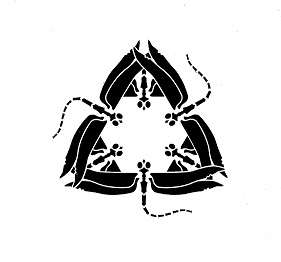
六 トンボ 鎧
(Six Dragonfly Armory)
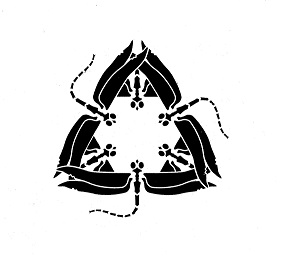
 |
Roku Tonbo
Yoroi 六 トンボ 鎧 (Six Dragonfly Armory) |
 |
| Home Kabuto Dou Sode Kote Haidate Suneate Full Suits Youth Armor Ordering Policy Garb Service Books |
This page is dedicated to the memory of Date Saburou Yukiie and the work he did as an armoror in the Society for Creative Anachronism.
Roku Tonbo Yoroi End
of Year Statement/Update
It’s been a long, but
very fast year this past year and I have decided to make some changes to how I
fill/complete orders.
The first change will be,
I will be adding Obi to the Dou/Full Suits as I have been seeing that customers
do not or have been wearing an Obi with their Dou.
Dou are always worn with an
Obi.
They will be at cost from the
online Martial Arts supplier I will go through
(https://www.karatemart.com/colored-rank-belts), and there will be many colors
to choose from.
The second change will
be, I will no longer be changing when I complete an order so that the armor that
has been ordered can be worn at an upcoming event.
I do understand that customers
want to show off what they ordered and are super excited to show off and wear
it, but the accelerated deadline not only causes me to cut corners, it also
causes every order (other than that customer’s order) to be delayed
exponentially.
I try my best to complete
orders in a timely fashion but have found that I am getting way too far behind
on other customers’ orders.
I am currently so far behind
on making and attaching kusari that I have no idea when I will be caught up
(think 2 years behind).
The third change will be,
I will now be asking for a minimum of 2 years to complete a full suit of armor
(depending on the level of detail, it can be longer) so I can give the best
quality armor I can possibly give.
And, 2 years is still quicker
than how long a real suit of armor would be built (3-5 years, as stated by the
late Kacchu-shi Hiromichi Miura at the 3 minute mark,
https://www.youtube.com/watch?v=p7CRFwS3m_k&t=148s).
I am asking for the 2 years so
I do not get into the backlog I am experiencing right now.
If a Hon Kozane Armor is
ordered, which also includes an Oyoroi, I will require at least 3 years to
complete the armor.
I make all the hon Kozane by
hand to fit the customer.
They are not one size fits all
but scaled to the customer’s body measurements.
The Hon Kozane takes a lot of
time to manufacture before any of the lacing begins.
I
manufacture as many of the parts by hand as possible.
That includes every plate,
every Kusari link, every piece of Egawa and Shobugawa, stitching the Fusegumi,
just to name a few.
When possible, I do use a
drill press, sewing machine, and cordless drills.
I tend to follow what was
stated in the Star Trek movie “Insurrection”, “Our technological abilities are
not apparent because we have chosen not to employ them in our daily lives. We
believe that when you create a machine to do the work of a man, you take
something away from the man.” Daniel Hugh Kelly – Sojef”
I feel the same way about how
I build samurai armor.
I want every piece of armor I
build to have a soul.
That takes time to accomplish.
The fourth change will
be, I will be taking one day a week for Research and Development, or more
simply, updating patterns and wood forms and working on armors for the books I
am painfully behind on.
As for the books I am writing,
I will be adding another book to the list, How to Build a Japanese Style Tent.
I know there are several
people who would love to know how I built my tent (that I’ve used at pennsic)
and I’ve decided to put it all in a book.
The fifth change will be,
I will be adding older style armors, Tanko and Keiko, to the list of armors I
offer.
I will need to build one of
each so they can be seen prior to purchase, so it will be a while until they are
added to the list of armors offered.
I’m adding these armors so
there will be more diversity of armors on the battlefield.
The sixth and most important change will be, this coming year I will be
focusing on finally finishing the relacing of my best friend’s, the late
Christopher Wright/Date Saburou Yukiie, armor as it is the 10th
anniversary of his passing, and it is high time I get it done.
I will also be working on the
Urushi Old Style Haramaki-do suit I was working on.
It, also, is high time I at
least try to finish it.
The seventh change will
be, I will no longer be using hidden elbows for the Kote.
After rebuilding a set of kote
twice for a customer and seeing what the hidden elbows were doing to the fabric,
it no longer makes sense to do hidden elbows.
I will be making the required
elbow protection removable so that the kote can be worn without them if need be.
If hidden elbows are
requested, I will be using very low-profile plastic cops.
Meaning, they will offer just
enough protection to pass inspection.
*Updated Prices*
Due to the rising price of steel, I have increased my prices to reflect that increase. I will also be using lacing from www.fusahimo.com exclusively from here on out as their odoshi is a close match to real silk odoshi, even though it is acrylic. I decided to use their odoshi so that the armor I build is even closer to historical armors that used silk odoshi. The updated prices also reflect the increased cost of the odoshi.
Misson of Roku Tonbo Yoroi
The mission of Roku Tonbo Yoroi is
simple, provide quality SCA Japanese Armor at reasonable prices.
Below can be found various armors that can be purchased, either piece by
piece, or complete suits (Head to Toe).
I am now accepting orders for any non-SCA related armor needs, and
includes but is not limited to, Martial Arts, LARP, etc..
I will adapt the armor to fit your needs.
I only do complete builds, NO DO-IT-YOURSELF KITS.
That means, I will not cut out, drill, then send the pieces for you (the
customer) to complete.
See Ordering Policy
It is my wish to show the
Knowne World the beauty of Japanese Armor, but within the confines of
SCA Heavy Combat.
I can also adapt any armor to be used for SCA
Fencing or Cut and Thrust.
Please spend a few moments, and browse
my wares. If you see something you would like to purchase, please
message me at:
rokutonboyoroi@gmail.com
or at:
Roku Tonbo Yoroi
on Facebook. Date Rokurou Yoshimitsu
If you would like a catalog, please e-mail me with your name and
address and I will get one to you.
There are more options and pricing in the catalog.
Introduction from
the Past
Original introduction from Date Saburou Yukiie
from the early 1990s when he was known as Kaminari Date.
| "Unto the populace of the Knowne World do I bid greetings.
Konnichi wa. In the Hagakure, a collection of the writings of the Samurai Yamamoto Tsunetomo, it is said that '...one must first account for all of the armor of one's station in life before it may be properly displayed.' In this respect I humbly ask to be of service, and to provide for your armor needs. Irrasaimasse! I am Kaminari Date Tengu no Kami no Togoku, an SCA member (both active and inactive) for ten years. Originally an East Kingdom-Debatable Lands native, I have been traveling far and wide in search of the knowledge of my chosen art. I actually lived in the Japans, there studying for three years traditional Kendo under Sensei Ishikawa Oshiro, and scouring through book vendors and libraries, from Hokkaido to the Ryukus. I now offer some of the results of my quest. Fully armored Samurai wore several pieces of armor typically protecting their entire bodies - a Kabuto (Helmet), Menpo (Facial armor), an Eruwa or Nodowa (Throat armor), a Do with Sode (Body and Shoulder armor), Kote (Armored sleeves), Haidate (Thigh armor), and finally, Suneate (for their shins). The style depended on the current period, individual taste and economic means, social position, rank, and the dictates of ones [Daimyo]. The more prominent the individual the more elaborate their equipment was likely to be. Herein are several versions of period armor worthy of Court and Combat, rendered for you in the Japanese styles. Historically, armor was lacquered not only as a measure against rust, but for strength and decoration. Lacquer colors were made from natural materials in browns and black, and was sometimes overlaid with vermillion, gold, or silver powders. The lacing that bound the plates together was either of a single color, or combinations of white, pale or bright blue, yellow, green, red, brown, and black. Some combinations were historically restricted; for instance, milkan (orange) was the Buddhist color, and beni (a bright scarlet) was reserved for the Five Regent Families until the Meiji Reformation, in the 1870s, on the basis of it being too expensive and beyond the means of normal subjects. I therefore will not render any harness in those schemes. I do this for artistic and historical reverence. Gomen nasai. Except in the case of squad level issued equipment, armor should reflect the personality and taste of the wearer. I keep records of each buyer's purchase that they may order matching equipment in the future, yet have little fear of meeting their exact duplicate on the Field of Battle. I will try to work with you to your complete satisfaction." Kaminari Date aka Date Saburou Yukiie, 1990s. |
 Date Saburou Yukiie, circa 1990s. Founder of Roku Tonbo Yoroi. |
Introduction from the Present
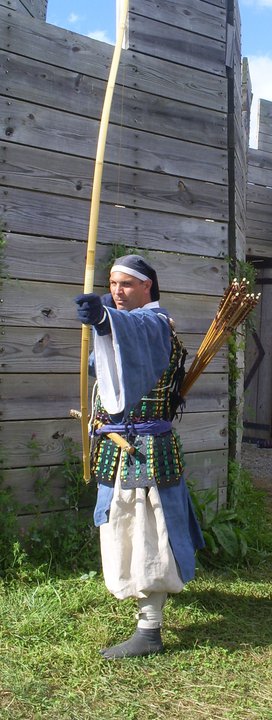 |
Ohayogozaimasu! Please allow me to introduce myself. I am Date Rokurou Yoshimitsu. I began my life as Momochi Takezo in the village of Fushimi over looking Fushimi Castle, in the year 1525. My parents were of humble origin, my adoptive father, a resident of Kizu village, and my mother, a resident of Ueno village, ended up in Fushimi village after a raid in the mountains surrounding Ueno. During my fathers’ lifetime, my adoptive father tried unsuccessfully to assassinate Oda Nobunaga on various occasions, resulting in him being assassinated himself. As Momochi, I searched a myriad of commissioner's offices and boxes of scrolls and documents and found that he was indeed of the Family Date, and decided to reclaim the Family name, taking the name Date Rokurou Yoshimitsu. I wish to finish off Oda sometime in the future, to avenge the man who raised me as his own. Currently, I reside in the East Kingdom of the Known World where I am the loyal Family member, and heir, and Great-Great-Grandson of the late Date Saburou Yukiie. I am the current armor builder for Roku Tonbo Yoroi. I have studied various martial arts, shoot a yumi (Japanese long bow), and currently continuing my study and building of Japanese armor, to preserve the noble Samurai ways of the Date. It has been told, that I am quite a Kumihimo (cord braiding) expert, and use it on the armor I build or the Garb I sew. I have been a member of the SCA (Society for Creative Anachronism) since 1991, and have played in the Kingdom of Caid, the Kingdom of the East, the Kingdom of the Middle, the Kingdom of Aethelmearc, and the Kingdom of Atlantia. I have earned an Award of Arms (AOA), Service Award (Barony of Stierbach,Atlantia), Order of the Silver Wheel (East, for A&S), and Order of the Silver Brooch (East, for A&S). I am also, a Royal Armorer to the current King of the Middle Kingdom, HRM Sir Seto Gesshuko. Mundanely, I have traveled the world with the U.S. Marine Corps where he spent time in the infantry learning how to play with explosives and blow up buildings, and in aviation where I spent my time repairing the electrical systems on attack helicopters. Currently, I am living in Northern Delaware, and I am doing my best to adjust to my new surroundings. My education is in Secondary Education Social Studies (History, Geography, Psychology), with a Minor in History, and Content Credits in Special Education. I am also the proud father of two beautiful daughters. |
Introduction
All armor is built using patterns
and instructions from
www.sengokudaimyo.com/katchu/index.html.
Lacing that is used for the armor can come from
www.fusahimo.com (which offers a
wide variety of colors, especially various gradiations/shades of colors,
which are used for different lacing designs).
Armor construction material choices include (except for the Kabuto),
ABS, HDPE Sheet (not Barrels), or Steel. My personal armor is
built from 3/16" ABS and have had only one plate crack (lower plate on a
sode), but I was fighting outside in December while it was snowing.
Prices reflect current material costs, and can change at any time.
All armor pieces that have fabric are armored. That means, they
contain plates or scales in their construction. I will not make
foam filled pieces. I will not do it, so don't ask.
Complete suits of armor (head to toe) can be purchased at a combined
reduced price. Prices will be quoted at time of inquiry.
Length of time to completion can, and will, increase to 1 Year or
more, depending on the suit and options desired.
Please be as accurate as possible when taking your measurements, as I use the measurements you give me to build your armor. So, if the armor does not fit when you get it, it is because of an error in your measurements. So, please be as accurate as possible. If you have any questions as to what a measurement means, please do not hesitate to contact me.
I will no longer be adjusting build times s that
you can wear the armor you ordered, at an event that is coming up. You
need to give me enough lead time, especially for a full suit, so I can complete
the build. If you insist on wanting your armor by a certain date/event,
there will be a 25% increase in cost of the armor.
The prices do not reflect shipping costs,
as *Shipping costs are the responsibility of the customer*, and are through
UPS or FedEx.
Armor
鎧
Kabuto
かぶと
The Kabuto is Japanese for Helmet
and it can come in many forms. The basic form is the multiplate.
It can be as simple as haveing only 8 plates, or as many as 120 plates.
I offer 8 and 16 plate versions, and will be working on creating a 32
plate in the future. There is also a Zunari which has only 4
plates and the Kittate which combines both the multiplate and zunari
styles. I offer all of them, below. All kabuto include the steel to
build them, paint (black, dark brown, red), lacquer finish, and lacing
of the shikoro. I will deviate from the three paint color choices,
but I will NOT do blue, white, or any color that was not done prior to
1600C.E.
All Kabuto are built as though they would have exisited prior to
1600C.E., so proper throat protection (Guruwa/Gorget) with cervical
protection needs to be worn. I would also suggest attaching upper
chest protection to the front of the Guruwa/Gorget, as well.
Lacing of the shikoro can be done in
Sugake Odoshi or
Kebiki Odoshi. The lacing should match the lacing
of the rest of the armor, but could be a different style as per the
wearers preference. Odoshi styles can be seen
below the Dou Section.
* Padding and chin strap are not included
(unless otherwise stated) and it is
up to the individual customer to do their own.*
All Kabuto now come with an under solid neck plate and new bargrill
design where the bottom of the bargrill tucks under the chin.
Please refer to the Ordering Policy when ordering a Kabuto. Thank you.
Multiplate Kabuto
32 Plate Ribbed Kabuto
$800 USD
An additional $100 USD is required for any hybrid modifications for Fencing/Cut & Trust.
Multiplate Kabuto are just that,
kabuto built with multiple pie shaped plates which form the bowl of the
kabuto. All multiplate kabuto are built from 16ga steel, and come
with a bargrill, your choice of shikoro, paint color (black, red, dark
brown) and spray lacquer finish. Sizing of the kabuto
is based on the wearers head circumference, so that they may fit closer
to the head (with the required 1/2" of padding as per SCA armor
standards).
I will work with you, if you want the kabuto to be a bit larger for more
padding, or if the kabuto will be used for Heavy and Fencing (making the
bargrill removable).
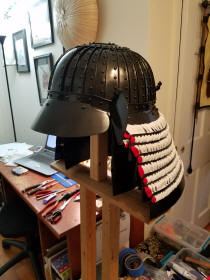
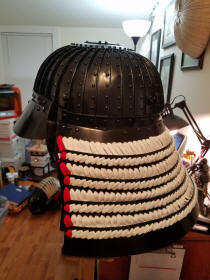
Basic 32 Plate Kabuto
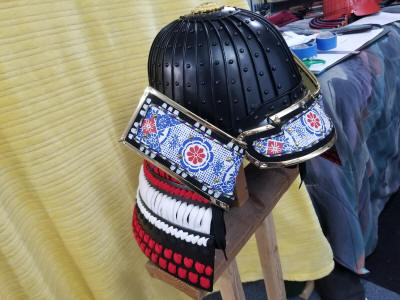
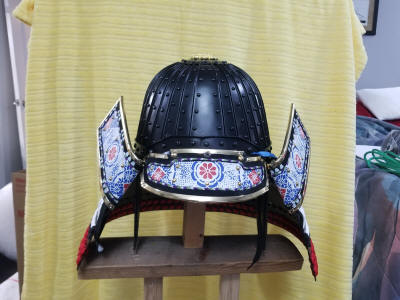
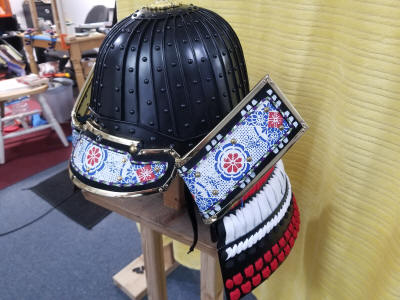
32 Plate Kabuto with rectangular fukegaeshi and thee lame shikoro. The mabizashi and fukegaeshi are covered in egawa, shobugawa, fusegumi, and polished brass ABS fukurin. Also has a rmovable bargrill (not shown).
Price: $875 USD as shown
Multiplate, 8 and 16 plate
$650 USD
An additional $100 USD is required for any hybrid
modifications for Fencing/Cut & Trust.
An additional $50 USD is required for 14Ga
steel.
An additional $100 USD is required for ribs.
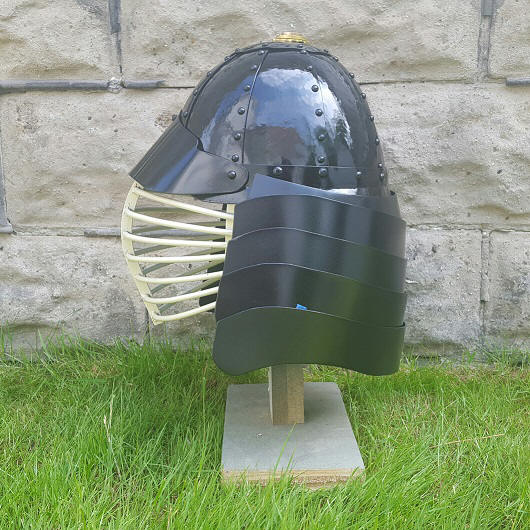 8 plate Kabuto, with a bargrill, and Hineo-shikoro, painted black with the bargrill painted almond. Customer supplying and lacing the shikoro. |
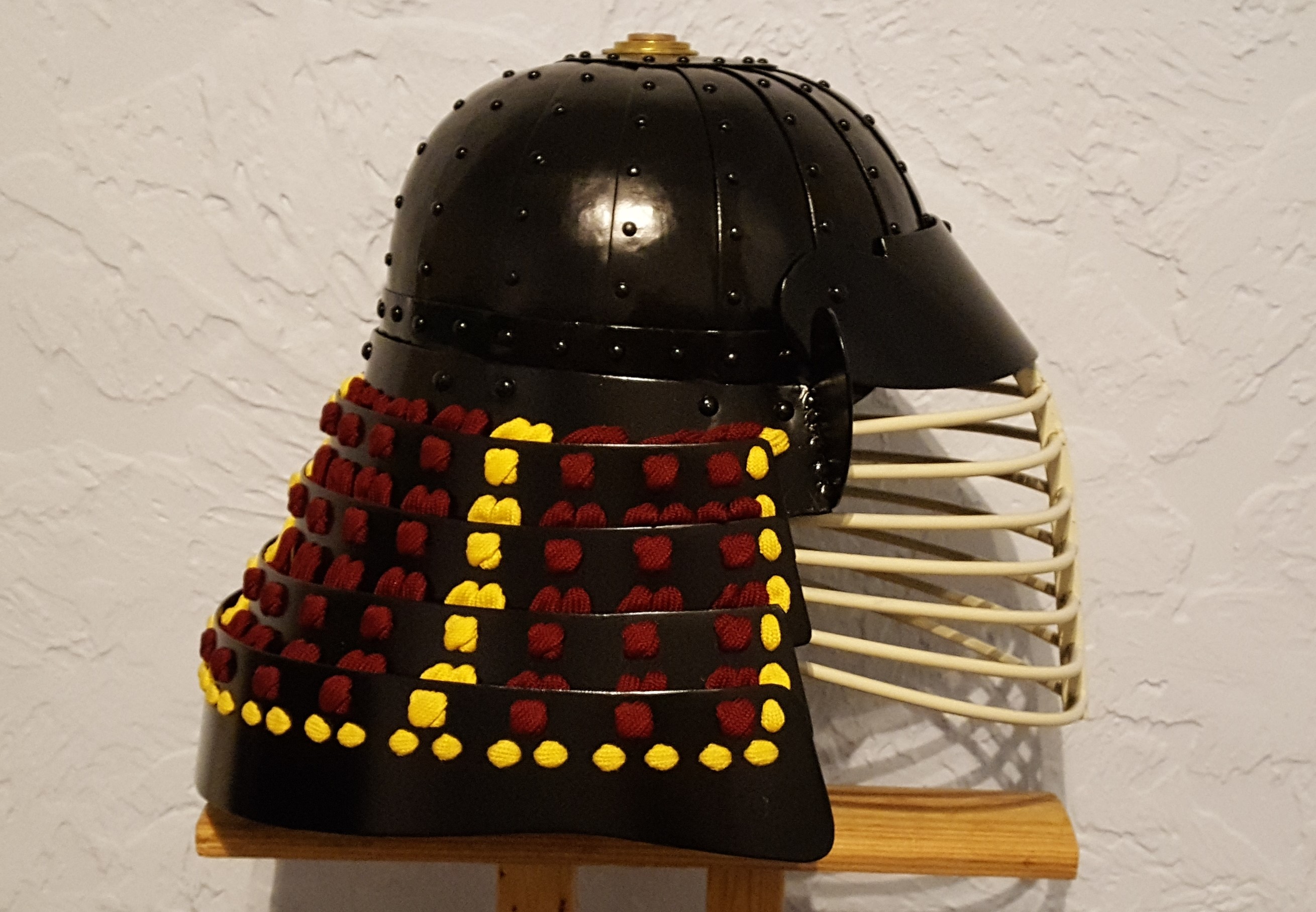 16 Plate Kabuto, with a bargrill, and Hineo-shikoro, painted semi-gloss black with bargrill painted almond. |
Zunari-kabuto
ずなり かぶと
$650 USD
An additional $100 USD is required for Cut & Thrust
modification.
Zunari-kabuto are kubto that are made from two side plates, a ridge plate, a wrapping plate, and a visor (which creates the bowl). All zunari-kabuto are built from 14ga steel, and come with a bargrill, your choice of shikoro, paint color (black, red, dark brown) and spray lacquer finish. Sizing of the kabuto is based on the wearers head circumference, so that they may fit closer to the head (with the required 1/2" of padding as per SCA armor standards).
I will work with you, if you want the kabuto to be a bit larger for more padding, or if the kabuto will be used for Heavy and Fencing (making the bargrill removable).
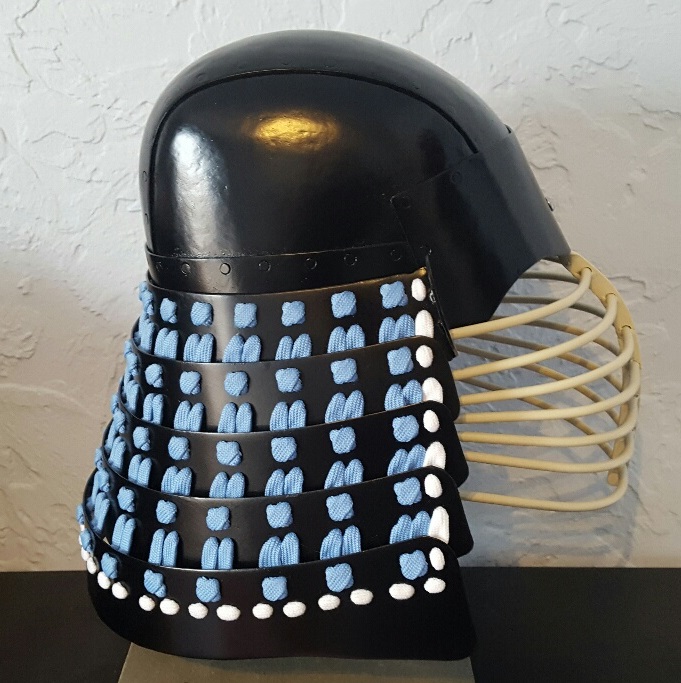 Zunari-Kabuto with Bargrill |
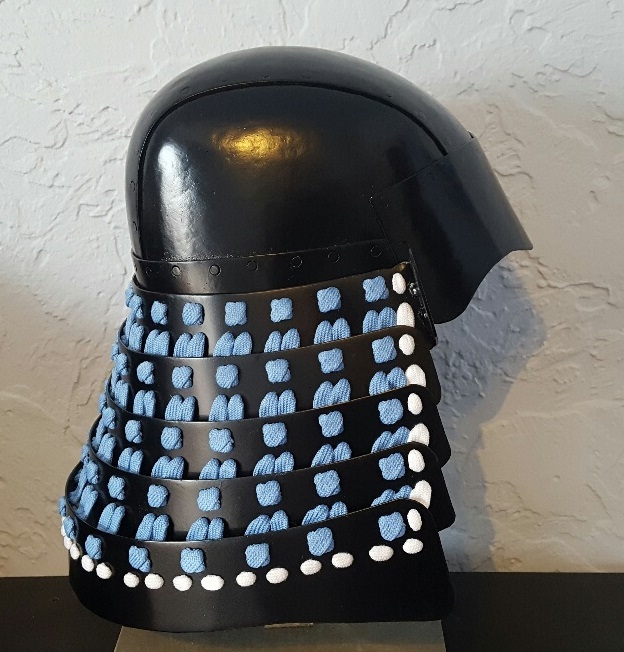 Zunari-Kabuto |
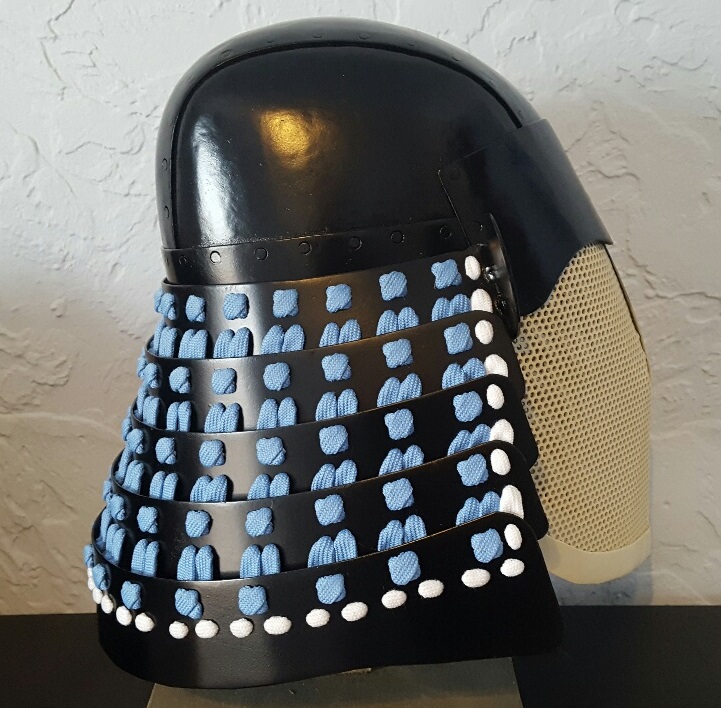 Zunari-Kabuto with Cut & Thrust Mask |
Oki Tenugui Kabuto
きったて の かぶと
$750
An additional $100 USD is required for Cut & Thrust
modification.
Oki Tenugui Kabuto are a hybrid kabuto and
contain elements from both the multiplate and zunari-kabuto, and
represent the look of the eboshi (floppy black cloth hat worn by
samurai) when it is flopped back over the head. All kittate no
kabuto are built from 14ga steel, and come with a bargrill, your choice
of shikoro, paint color (black, red, dark brown) and spray lacquer
finish. Sizing of the kabuto is based on the wearers head circumference,
so that they may fit closer to the head (with the required 1/2" of
padding as per SCA armor standards).
I will work with you, if you want the kabuto to be a bit larger for more
padding, or if the kabuto will be used for Heavy and Fencing (making the
bargrill removable).
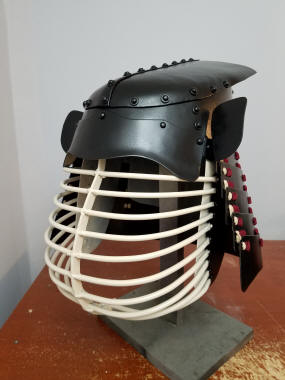 |
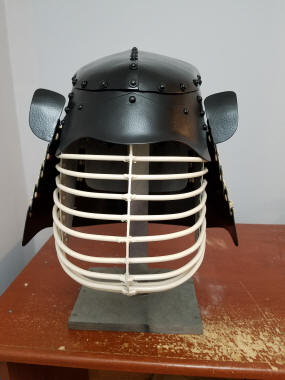 |
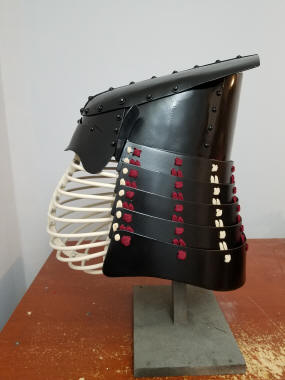 |
Shikoro Style Options
しころ
There are many different styles of Shikoro, which are the plates on the back of the kabuto bowl and protect the neck. I offer four different style of shikoro; the Ichimanju-jikoro; the Komanju-jikoro, the Etchu-jikoro, and the Hineo-jikoro. The shikoro can come with or without fukigaeshi (foldbacks), and the typical style I attach looks like an ear. All four would be considered list legal safe and can be seen in the pictures below. If you are not in the SCA and would like a different style shikoro, than those shown below, please let me know and I will accomodate you.
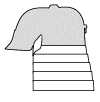 Etchu-jikoro |
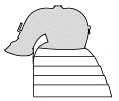 Komanju-jikoro |
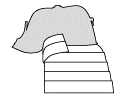 Ichimanju-jikoro |
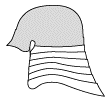 Hineo-jikoro |
Nodowa
のどわ
The nodowa (lit. “throat ring” — note, it’s pronounced nodo-wa, not no-dowa) is not so much a gorget as we think of them for SCA combat as a defense for the lower throat. It does not replace proper list legal throat/neck protection. But, it can finish the look of a suit of armor.
| HDPE 3/16": $85 1/8": $80 |
ABS 3/16": $80 1/8": $75 |
STEEL 16 Gauge: $95 18 Gauge: $80 |
 |
Guruwa
The guruwa is the throat armor and is similar in design and function as the gorget. For SCA Heavy Fighting, it is required, especially when wearing any of the above kabuto.
Each guruwa comes with 3 dangly bits in the front that will cover the upper chest area and 2 dangly bits in the back to cover the cervical vertebrae. There are 2 material options for the "ring" of the guruwa, steel (16 Gauge) and ABS (3/16"). I do not suggest using HDPE, as it has a tendancy to want to spring back to flat. The dangly bits can be made from the same material as the armor is made from so they match.
The guruwa shown below is made form 16 gauge steel with ABS dangly bits.
| Steel, 16 Gauge Sugake Odoshi: $150 Kebiki Odoshi: $175 |
ABS, 3/16" Sugake Odoshi: $125 Kebiki Odoshi: $150 |
Dou
どう
The Dou is the main part of the armor and is worn on the torso. It comes in many different styles the Mogami-do and Haramaki-do being two of the most common. There is also the Sendai-do, which originated in the Sendai region of Japan, and was a favorite of Date Masamune. I offer all three, including the Dangae-do which combines two different styles (as far as lacing and scale styles), and the Oyoroi which is a Great Armor. Armors will have options for lacing styles, kebiki odoshi or sugake odoshi, if they were laced either way. No matter the style of armor, all will use Tomegawa, or stopping leathers, in their construction. Tomegawa is what keeps the Dou solid. Without it, the Dou would accordian when placed on the ground, and not sit up strainght and tall. All tomegawa will be made of rawhide lacing.
All dou can come in several different hinge configurations. A typical Mogami-do can be a gomai-do, a rokumai-do, or a nimai-do, just to name a few. The configurations can be found after the Oyoroi, below.
All dou include the material they are to be made from, all lacing, all closure ties, sode ties, and tomegawa (where applicable). It is highly suggested an obi be obtained and worn with the dou, as it is proper for the dou to be worn with one. Without an obi, it just doesn't look right.
Please refer to the Ordering Policy when ordering a Dou. Thank you.
Do-Maru
胴丸
There were quite a number of similar styles and types of Japanese armor; the dō-maru is particularly defined by the fact that a dō-maru opens on the right side as opposed to the haramaki style which opened in the back and the ō-yoroi the cuirass of which is completely open on the right side requiring a separate plate (waidate) to cover the right side. The ō-yoroi was a heavy box like armour meant for use on horse back, it was also expensive to make. The dō-maru like the haramaki had more skirt plates (kusazuri) than an ō-yoroi and was lighter, closer fitting and less expensive to make. The dō-maru was easier to fight with on foot and eventually even higher status samurai adopted the dō-maru over the ō-yoroi.
Dō-maru were constructed from small scales of leather or metal laced into plates with cord and lacquered. Then each plate was laced together, typically using kebiki odoshi, to form the armor. Due to the weight of iron, armour makers limited its use to the most vital parts of the armor and used leather for the remainder.
The Do-Maru that I build are built using lames instead of individual kozane and can be made with kiritsuke zane or flat tops to the lames. I will build Do-Maru using kozane, but expect the build time to be increased 10 fold as it takes a lot of man hours to make the individual kozane (which will be sized to fit you, the customer, and the lacing being used), lace them together into boards, and then lace the boards together into the Do-Maru and the cost is listed below.
| HDPE 3/16": $675 1/8": $625 |
ABS 3/16": $650 1/8": $600 |
STEEL 16 Gauge: $700 18 Gauge: $650 |
KOZANE $1500 |
The Do-Maru below is constructed of 3/16" HDPE and has 5 hinges (typically a Do-Maru lacks hinges but due to the material being used, the hinges help with the shape). It is laced in kebiki odoshi lacing and has 11 kusazuri. It also has Tate-Eri and basic brass Kanamono, which are listed below and can be purchased at an additional cost.
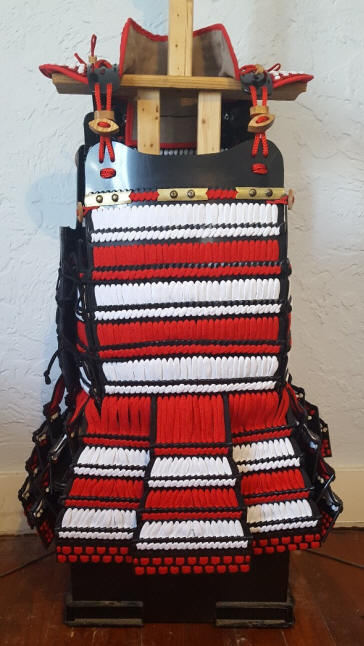 |
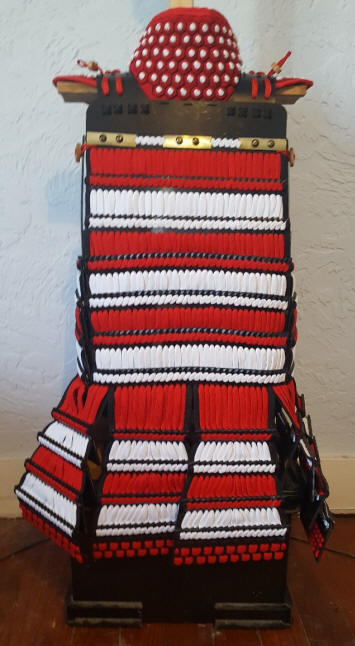 |
Haramaki-do
はらまき どう
The Haramaki-do is
a dou which opens in the back, but does not close all the way, so the
spine is exposed. They were originally retainer armors, but are
very popular in the SCA. Haramaki-do of the 1400s, were of Hon
Kozane construction and Kebiki Odoshi laced. Later period
Haramaki-do were made of solid lames, iyozane, kiritsuke zane, and hon
kozane construction, and were laced according to the scales used, Sugake
Odoshi becoming the norm.
Haramaki-do, that I build, can be Kiritsuke Zane and Solid Plate
construction (with the solid plate tops being whatever the customer
wants), and laced according to the style chosen. I include a
Sei-ita, at no extra charge, as I believe in giving the wearer the
option to wear it, or not (if not wanted, please let me know at time of
ordering). Depending on the style desired, I offer kebiki or
sugake odoshi for the lacing. The opening can be edged in light
weight leather so the plate edges do not pinch the wearer.
At this time, I cannot offer the Agemaki Ring on the Sei-ita, as I do
not have a source for the ring, at this time. In the future, I am
hoping to have them to add to the Sei-ita.
The Haramaki-do is offered in Three
different building materials, Two different lacing widths, and Two different lacing styles, listed
below. There is a fourth option, I can build the Haramaki-do
using individual kozane, but expect the build time to be increased 10 fold as it
takes a lot of man hours to make the individual kozane (which will be sized to
fit you, the customer, and the lacing being used), lace them together into
boards, and then lace the boards together into the Haramaki-do, and cost is
listed below.
Add $50 to the listed prices below for Kebiki Odoshi lacing, except for the Kozane pricing which includes kebiki-odoshi. Prices listed below include Sugake Odoshi lacing, a Sei-ita (Cowards Plate), all toggles, and all ties.
| HDPE 3/16": Starting at $675 1/8": Starting at $625 |
ABS 3/16": Starting at $625 1/8": Starting at $575 |
STEEL 16 Gauge: Starting at $650 18 Gauge: Starting at $600 |
KOZANE $1500 |
The Haramaki-do shown in the photos, is made from 3/16" ABS; Solid Lames with Koishi Gashira top; using We Love Colors Hunter Green, Gold, and Red laces, laced in Sugake Odoshi; Hand made wooden toggles; 7 Kusazuri; Fabric panels for the Kusazuri suspension; and 3/16" white cord (although, I can thread the cord through the lacing to make round lacing, which would be more proper).
 Front |
 Back |
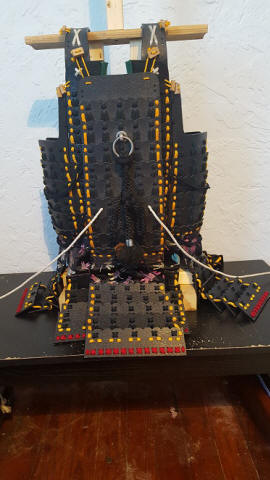 Back with Sei-its installed |
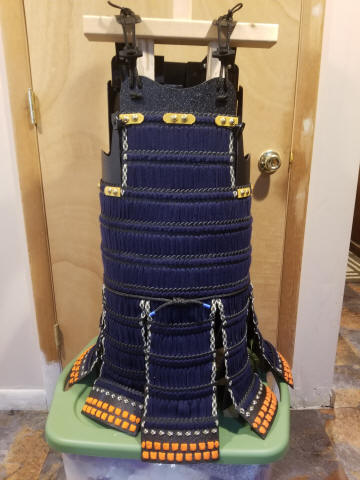
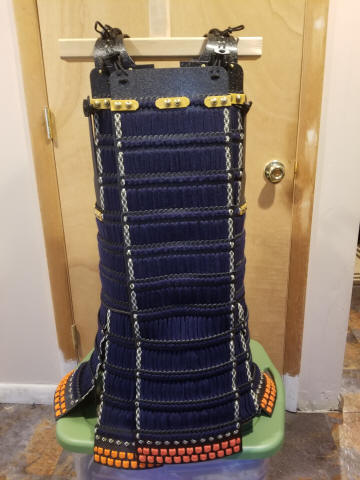
ABS (1/8") Old style Haramaki-do, kebiki odoshi laced (fusahimo odoshi) with sei-ita and 3d printed kanamono.
Sendai-do
せんだい どう
The Sendai-do, or the Yukinoshita-do is the only armor associated with an armorer, Yukinoshita Denshichiro Hisaie who created the armor sometime after 1573CE. Date Masamune is famous for equipping his entire armoy with them. It only comes as a gomai-do.
The Sendai-do below was constructed of 1/8" ABS, with Laces for Less Black and Gold Athletic Laces, hand made toggles, and 9 Kusazuri laced in Sugake Odoshi.
| HDPE 3/16": $525 1/8": $500 |
ABS 3/16": $500 1/8": $475 |
STEEL 16 Gauge: $550 18 Gauge: $500 |
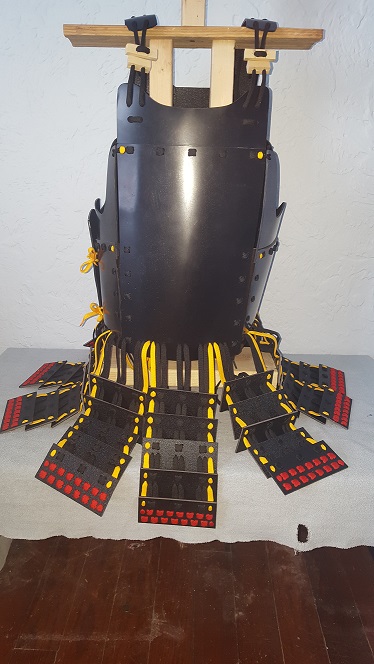 Front |
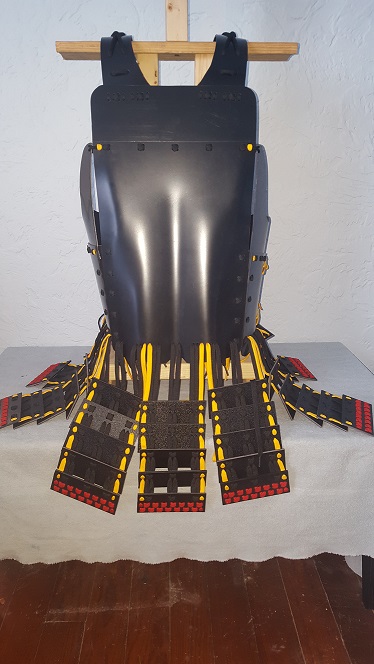 Back |
Dangae-do
だんがえ どう
The Dangae-do is
The Dangae-do pictured below is made from 16 gauge steel, for the body, and 18 gauge steel, for the kusazuri; with laces from shoelacesexpress.com 5/16" wide, is lined with a upholstery leather and quilted fabric liner, and custom made Gyoyo that have 1/8" thick Brass kanji.
| HDPE 3/16": $650 1/8": $625 |
ABS 3/16": $625 1/8": $600 |
STEEL 16 Gauge: $650 18 Gauge: $625 |
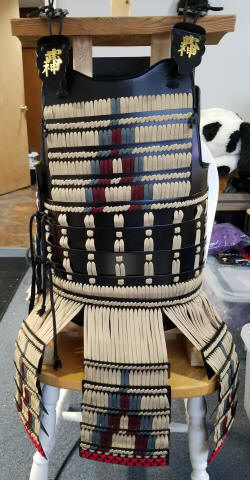 Front |
Oyoroi
だいよろい
The Oyoroi is the most luxuriant style of Japanese armor, and was common during the Heian Period ( ) to present day. The main part of the body wraps around the body and has a large opening on the right side. There is a separate piece, called the which is put on before the main part of the Dou is put on and fills in the gap.
The Oyoroi can be constructed of kozane, but expect the build time to be increased 100 fold as it takes a lot of man hours to make the individual kozane (which will be sized to fit you, the customer, and the lacing being used), lace them together into boards, and then lace the boards together into the Oyoroi, and cost is listed below.
| HDPE 3/16": $750 1/8": $725 |
ABS 3/16": $725 1/8": $700 |
STEEL 16 Gauge: $750 18 Gauge: $675 |
KOZANE $2000 |
NOTE: Any of the above Dou can be constructed from Kydex, and the starting price is $1200 due to the current price of Kydex.
Dou Options
Hinge Configuration
I can build any of the above dou with any of the hinge configurations shown below. Just understand, that some dou cannot use some of them, such as the Oyoroi, which does not use any hinges in its construction.

Plate/Scale Styles
| The type of scales used to build Japanes armor
are Hon Kozane, Kiritsuke Zane, Iyozane, and Solid Lames. Hon Kozane are individual scales sized to the width of the lacing being used and are laced together with a half scale overlap. Kiritsuke Zane are faked Hon Kozane and are made from built up lacquer on solid plates (for sca Japanese armor, it is made from filing the top edge of the solid plate to represent kiritsuke zane). Iyozane are another type of individual scale that is only barely laced together on the edge (I do not recommend this style of scale for sca Japanese armor as only the very edge of each scale overlaps). Solid lames are solid plates laced together in any style the wearer desires. The tops of solid lames can be shaped into kiritsuke zane, iyozane, or any number of different shapes, or left flat. Examples of each scale and plate can be seen at the right. |
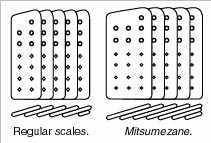 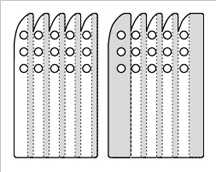 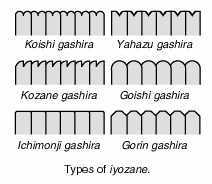 |
Odoshi Styles
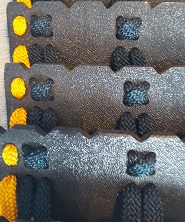 Sugake Odoshi 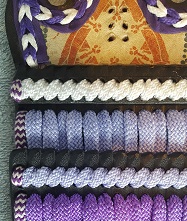 Kebiki Odoshi |
Odoshi is the lacing itself. It comes in
two styles, Sugake and Kebiki. Sugake Odoshi, or Sparse-point Lacing, appeared in the 1400s as an economical way of lacing armor, as it saved both time and expense of lacing material. Kebiki Odoshi, or Full Lacing, is one of the oldest forms of lacing an armor. It is luxuriant and thinck on the armor, showing no gaps. Both styles can be seen to the left. |
Lacing Designs
There are many different lacing designs, especially when an armor is laced in Kebiki Odoshi. The following link, http://www.sengokudaimyo.com/katchu/katchu.ch05a.html, will take you to an "Odoshi Lacing Patterns" page. I can do any of the styles shown on that page, except for the kon aka manjû gara (dark blue with a red swastika), so please do not ask me to do that one. There are many more lacing designs than what is on the link page. I will do any custom lacing design, as long as it is in good taste.
Accessories
Kanamono
The term kanamono refers to the various small metal plates that decorate and hold the armour together, the various rivets, and the ornaments.
The most common kanamono plates are the hassô kanamono, the ornamental, etched (and usually gilded) copper plates that serve as seats for the hassô byô that hold the cuirass to the munaita and wakiita, and in other places. There are two forms of hassô kanamono: one for the ends, and one for the middle. The hassô kanamono is really little more than an elaborately designed washer on steroids.
The kanamono I offer come in two different materials, Brass and 3D printed PLA. Prices and examples of each are listed below. Each set comes with the kanamono and solid brass rivets with cup washers to attach them.
| BRASS Dou Kanamono: $ Sode Kanamono: $ |
3D Printed PLA Dou Kanamono: $ Sode Kanamono: $ |
Tate-eri
Tate-eri are small padded pillow like pieces with a standing armoured collar that sits on the shoulder to protect from the weight of the breastplate or cuirass (dō). The standing collar would be lined with kikko (hexagon plates) armour to protect the neck.
If the tate-eri is being purchased with a Dou, they will be attatched to the Dou. Otherwise, they will be shipped as shown.
| For just the Shoulders: $50 For just the Neck: $75 Complete Set (Neck and Shoulders: $150 |
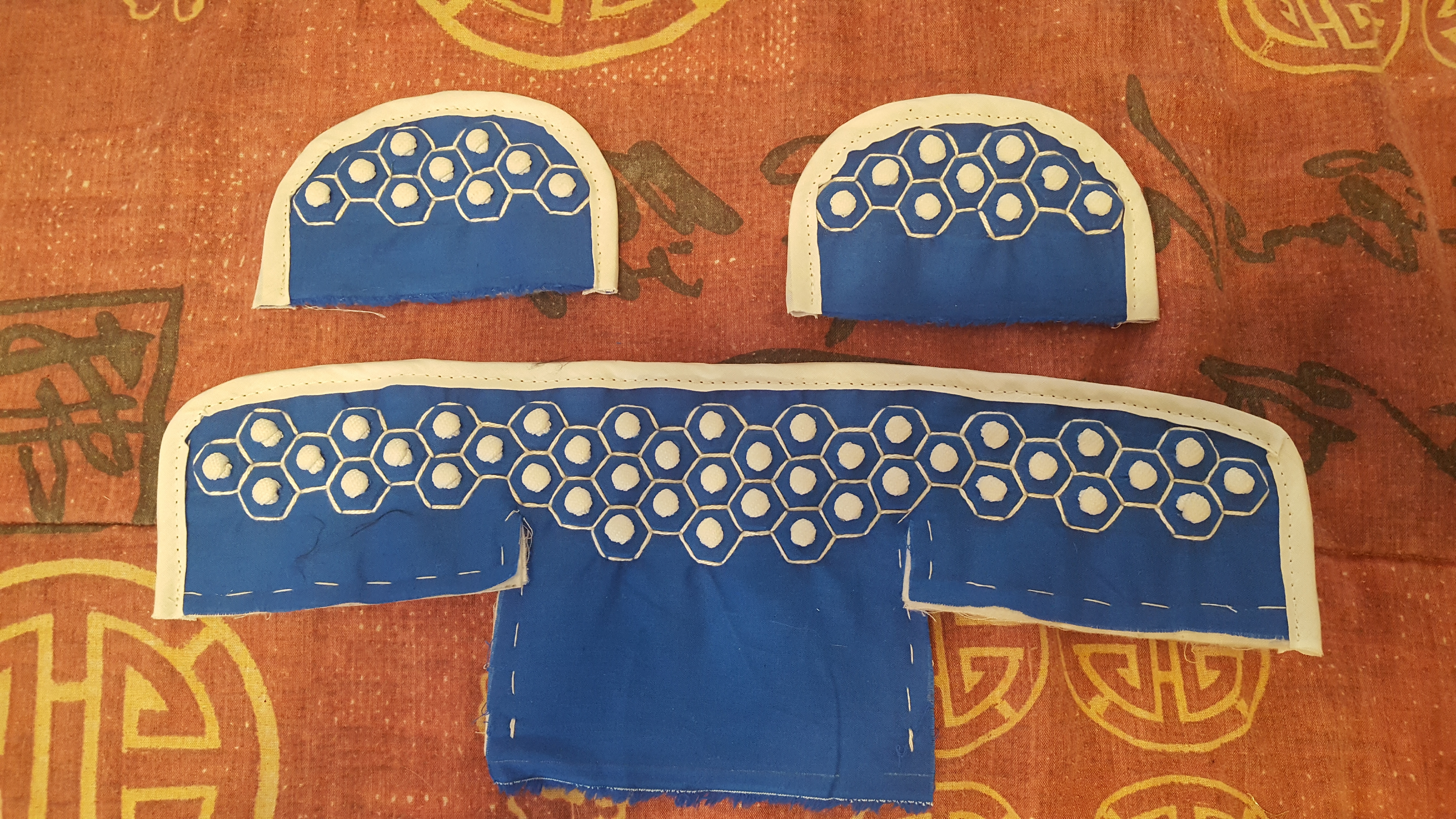 |
Egawa
Patterned leather
— called egawa — plays an important part in Japanese armour. Many plates are
covered by it, while other items use it to add integral strength.
Patterned leather is made from white doeskin, with the rougher surface
being used as the outside, although you can get away with using white
cowhide of about 4–5 oz. in weight.
The egawa provided here is printed on 2-3oz upholstery leather in fine
or coarse grain leather.
There are some dozen recognized patterns of
egawa, three
different patterns are available at this time. The normal color of
dyed leather is dark blue, almost a black, with highlights or scattered
details in red.
The egawa provided here can be printed in Navy Blue or Black, and Red
ink.
In older suits, designers would take care that the the pattern matched the
shape of the piece being needed (e.g., a small dragon centered
vertically on a tall, thin plate; two dragons horizontally on a long,
thin one). In later years, the design of the leather had little bearing
on the shape of the plate. Armourers try to center geometrics, of
course, but many designs are just random patterns intended to provide
some personality to the surface.
I will center or make the pattern as symetrical as best I can.
Period
egawa is made using thin metal stencils placed on the
surface of the leather. The printer then forces die into the cavities,
actually impressing the leather at the same time as it takes the ink.
You could also use a silkscreen, which is essentially the modern method.
All egawa is printed using silk screening.
Prices include:
Leather of choice,
Pattern of choice, and Basic set egawa for:
Munaita,
Wakiita, Oshitsuke-no-ita, Watagami, Haidate strips, Suneate
patch, and Sode panels.
Specialty pieces (typically used on Oyoroi) listed include:
Mabizashi
(visor)
panel, Fukigaeshi (shikoro
foldbacks) panels, Waidate panel, and Tsurubashiri
(dou front cover) panel.
When ordering, you will be required to provide paper patterns
of each piece of armor that you want covered. That way I can make sure the egawa pattern is centered or symetrical when
printed.
If ordering the specialty pieces, listed above, a mabizashi pattern will need to be provided, but only rough measurements are needed for the fukigaeshi and tsurubashiri panels.
| Pattern #1 Basic set: $75 Specialty items: Mabizashi: $30 Fukigaeshi: $30/pr Waidate: $45 Tsurubashiri: $60 |
|
| Pattern #2 Basic set: $75 Specialty items: Mabizashi: $30 Fukigaeshi: $30/pr Waidate: $45 Tsurubashiri: $60 |
|
| Pattern #3 Basic set: $100 Specialty items: Mabizashi: $45 Fukigaeshi: $45/pr Waidate: $55 Tsurubashiri: $75 |
|
Sode
そで
The sode I offer, are the Osode, or large flat sode that are typically worn with Oyoroi and are typically kebiki odoshi laced; the Kosode, which are smaller sode which are typcally worn with all the other armors and are typically sugake odoshi laced; and the Tsubo-sode, which taper in and become smaller towards the bottom plate and are typically, also, sugake odoshi laced.
Please refer to the Ordering Policy when ordering a Sode. Thank you.
The
osode are the huge rectangular upper arm defence that is typically worn with the
Oyoroi. They can also be worn with the Haramaki-do and the Maru-do.
HDPE Osode laced with shoelaces, with egawa, shobugawa,
fusegumi, brushed brass ABS fukurin, and 3d printed kanamono Chu-sode The
chu-sode are the medium sized sode that bend around the upper arm in a slight
arc. They can be worn with any dou, but not the Oyoroi. The chu-sode can be constructed of
kozane,
but expect the build time to
be increased 10 fold as it takes a lot of man hours to make the
individual kozane (which will be sized to fit you, the customer, and the
lacing being used), lace them together into boards, and then lace the
boards together into the chu-sode, and cost is listed below.
All chu-sode listed
are laced sugake odoshi. For kebiki odoshi, add $50.
For egawa (which also includes the edging leather and fukurin), add
$30.
ABS (1/8") Chu-Sode, sugake odoshi laced (shoelaces)
HDPE (3/16") Chu-Sode, sugake odoshi laced (shoelaces) with deerskin,
shobugawa, and fusegumi
ABS (1/8") Chu-Sode, kebiki odoshi laced (fusahimo
odoshi), with steel kanmuri-ita and 3d printed kanamono Tsubo-sode Tsubo sode
(of the Sengoku Period) are made similarly to conventional tôsei sode,
but with a deeper curve.Osode
だいそで
HDPE
3/16": $450
1/8": $400ABS
3/16": $400
1/8": $350Kozane, steel
18 gauge:
$500
20 gauge: $450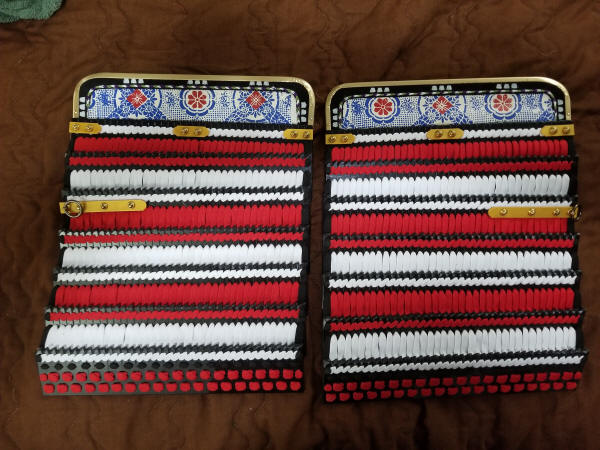
HDPE
3/16": $200
1/8": $175ABS
3/16": $175
1/8": $150STEEL
18 Gauge: $200KOZANE
$300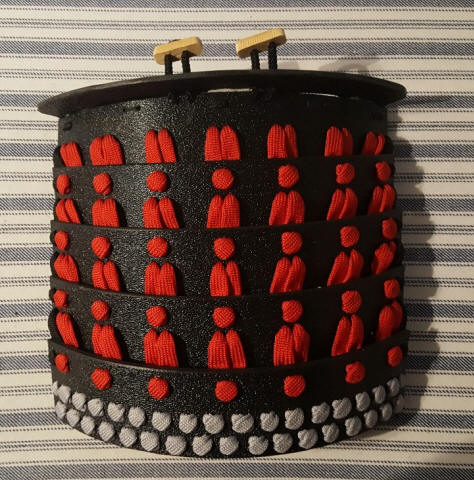
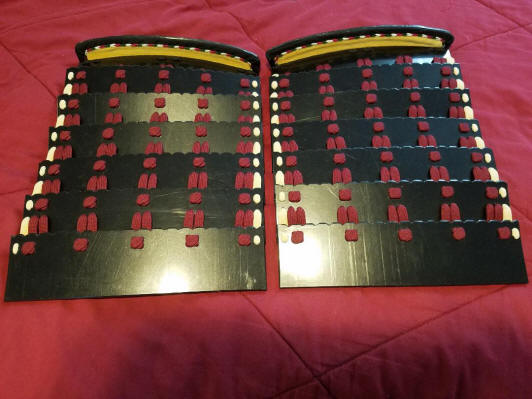
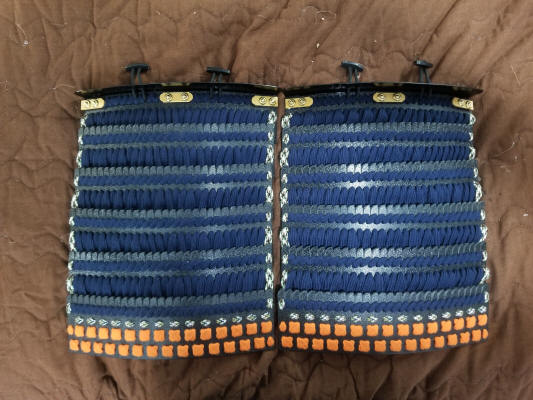
つぼそで
The tsubo-sode can be constructed of kozane, but expect the build time to be increased 10 fold as it takes a lot of man hours to make the individual kozane (which will be sized to fit you, the customer, and the lacing being used), lace them together into boards, and then lace the boards together into the tsubo-sode, and cost is listed below.
All tsubo-sode listed are laced sugake odoshi. For kebiki odoshi, add $50. For egawa (which also includes the edging leather and fukurin), add $30. The example below is laced in kebiki odoshi as per customer's request.
| HDPE 3/16": $175 1/8": $150 |
ABS 3/16": $175 1/8": $150 |
STEEL 16 Gauge: $190 18 Guage: $175 |
KOZANE $275 |
Tsubo-sode shown are made from 3/16" HDPE; laced kebiki odoshi; with simple kanamono and wooden toggles.
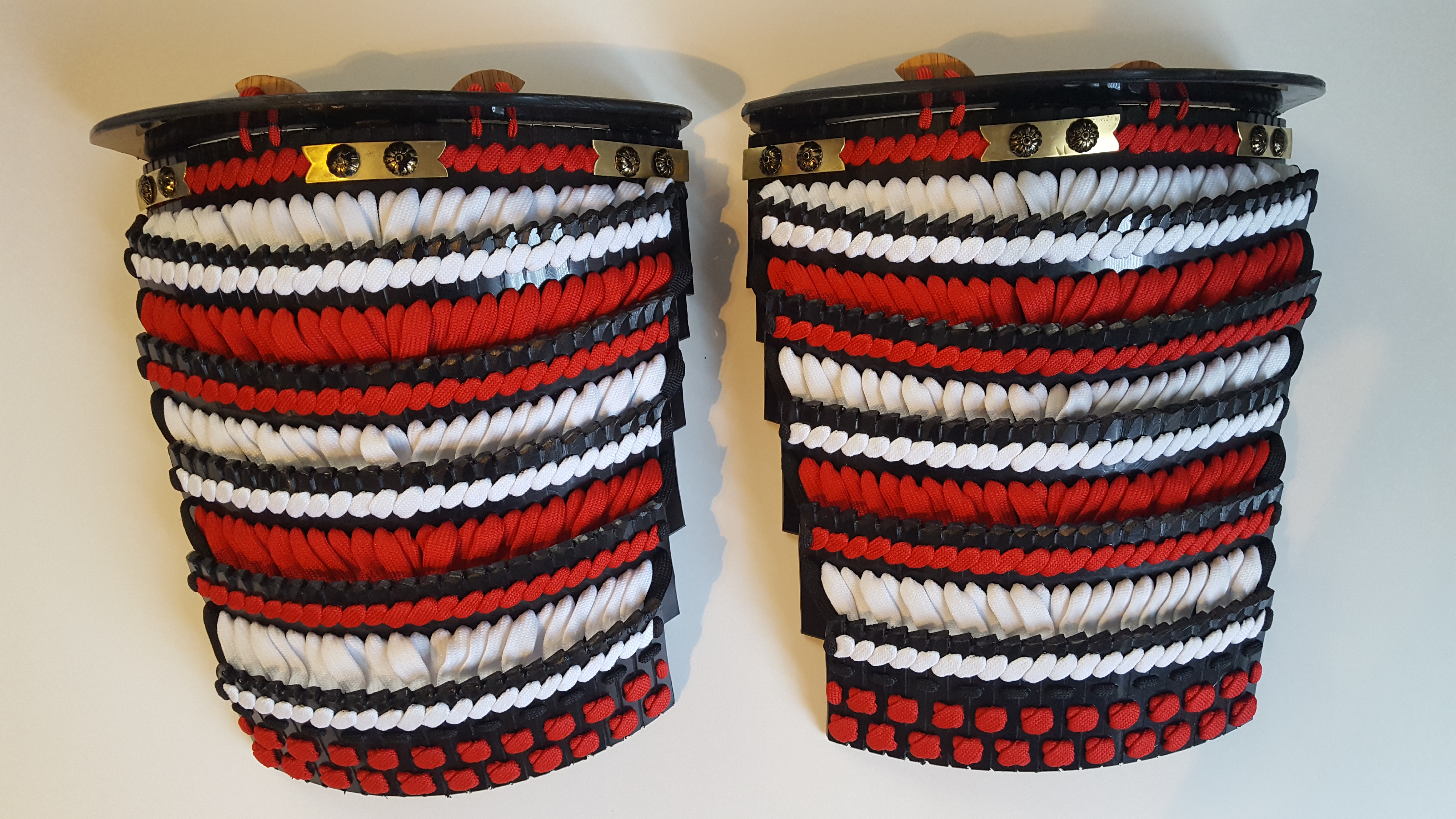
Kote
こて
The Kote, or armored sleeve, is a close fitting sleeve which protected the whole arm. They also came in many styles, but I offer the Shinogote, which has splints along the forearm, and the Tsubogote, which totally encloses the forearm.
All kote include three layers of fabric (the outer layer, middle layer, and inside layer), ties, and all plates associated with the style being built.
*PLEASE NOTE* The pricing of the kote is determined by the cost of the outer fabric being used.
Elbow cops are an additional $50.
Shinogote
しのこて
| HDPE 3/16": $275 1/8": $250 |
ABS 3/16": $250 1/8": $225 |
STEEL 16 Guage: $300 18 Guage: $275 |
The shino-gote shown, on the left, uses the older pattern for the fabric base and has linen as the inner layer, quilted material as the middle layer, and synthetic brocade as the outer layer. The plates are made from 3/16" ABS. It also has exposed elbows, made from 3/16" ABS.
The shino-gote, on the right, also uses the old pattern for the fabric base, but has hidden steel elbows.
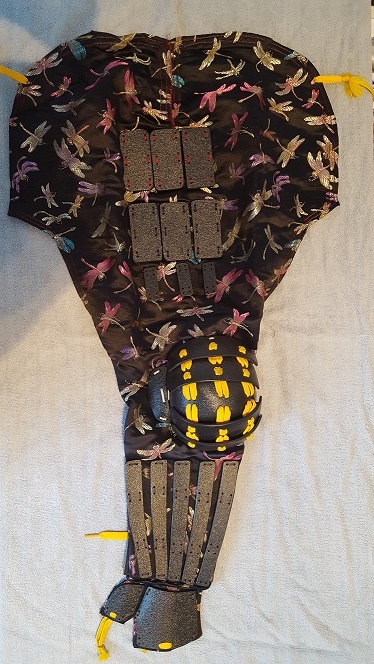
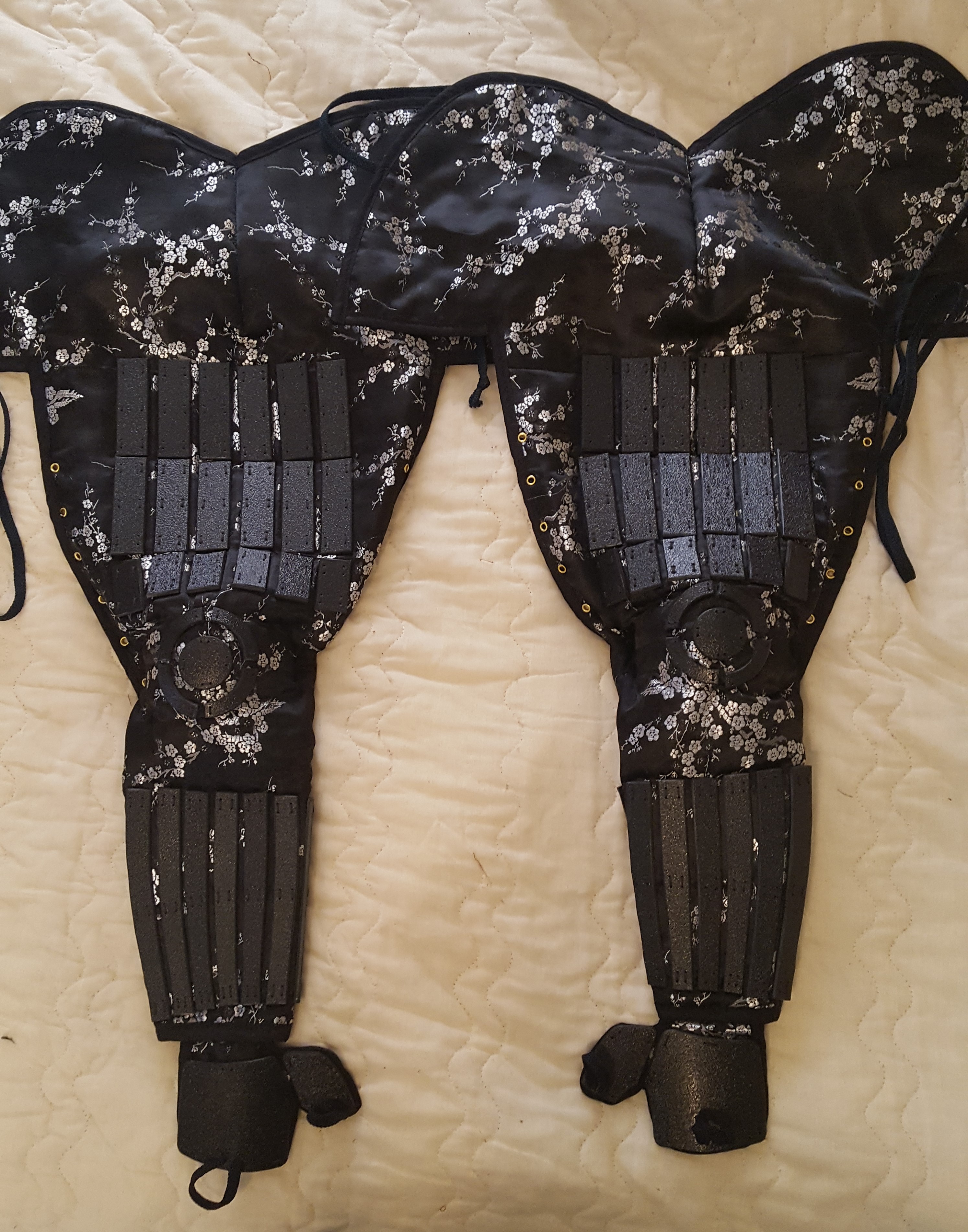
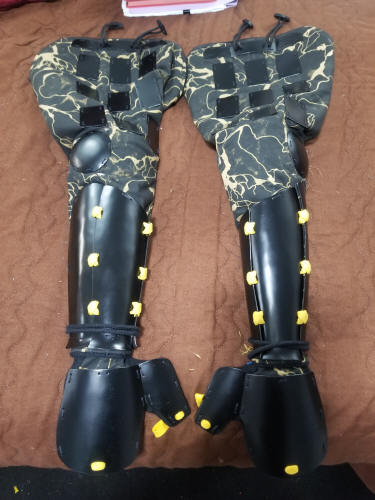
Haidate, or thigh armor, are a late occurance in Japanese armor, arriving sometime in the 13th Century. The haidate I build can have either a wooden toggle and button hole, or long ties to tie around the waist.
| HDPE 3/16": $275 1/8": $250 |
ABS 3/16": $275 1/8": $250 |
STEEL 16 Gauge: $300 18 Gauge: $275 |
KYDEX 3/16": $450 1/8": $400 |
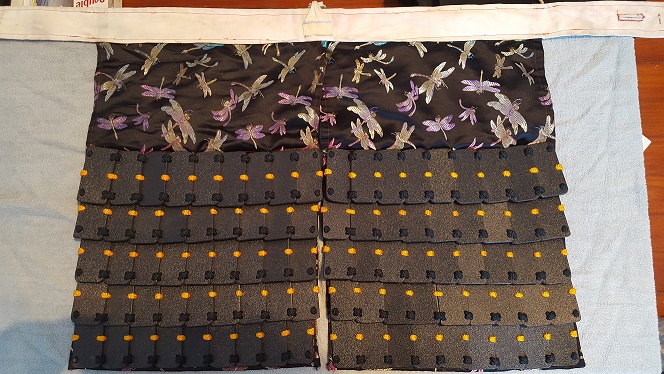
Kawara-haidate
| ABS 3/16": $300 1/8": $250 |
STEEL 16 Gauge: $350 18 Gauge: $325 |
KYDEX 3/16": $450 1/8": $400 |
The Kawara-haidate shown are made from 18 gauge steel plates, upholstery leather egawa, black leather, DMC floss fusegumi, Synthetic brocade, Cotton fabric, 1" wide cotton webbing, and 5/16" wide shoelaces.
Suneate
すねあて
| HDPE 3/16": $250 1/8": $225 |
ABS 3/16": $250 1/8": $225 |
STEEL 16 Gauge: $275 18 Gauge: $250 |
KYDEX 3/16": $350 1/8": $325 |
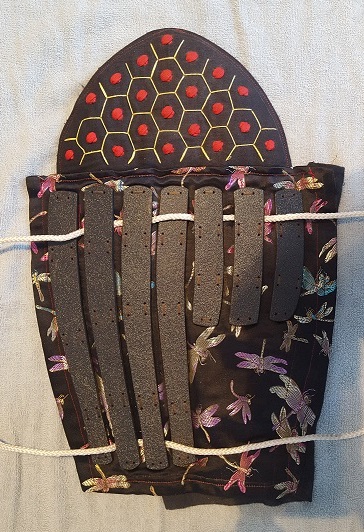
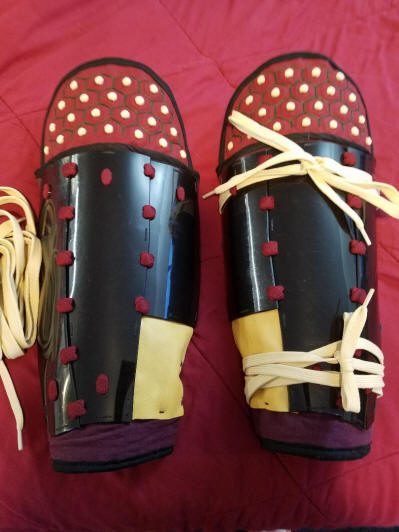
Tsubo Suneate
つぼ すねあて
| HDPE 3/16": $250 1/8": $225 |
ABS 3/16": $250 1/8": $225 |
STEEL 16 Gauge: $300 18 Gauge: $275 |
KYDEX 3/16": $350 1/8": $325 |
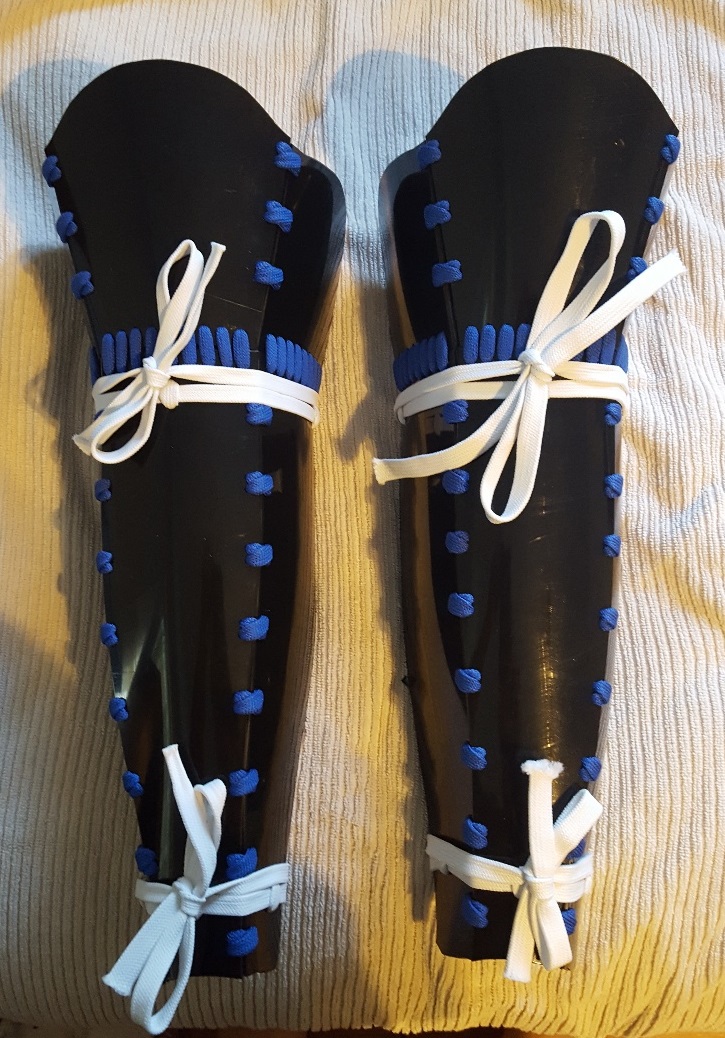
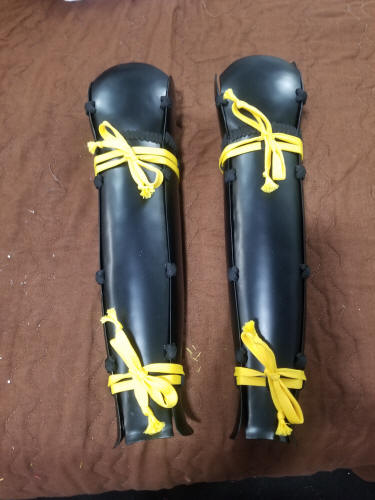
Full Suits
Full suits include a Kabuto (customer's choice), Dou (customer's lacing color choice), Sode, Kote, Haidate, and Suneate. Where applicable, there are two prices, one for Sugake Odoshi and a second for Kebiki Odoshi.
| Do-maru As shown, 32 Plate Ribbed Kabuto with under shikoro (padding and rope ties included); Basic Somen (padding and ties included); Kebiki odoshi laced Do-Maru with kanamono, egawa, and fusegume; Kebiki odoshi laced Chu-sode with kanamono, egawa, and fusegume; Shino-gote with hidden elbows; Kawara-haidate; and Shino-suneate Kebiki Odoshi: $3000 Sugake Odoshi: $2700 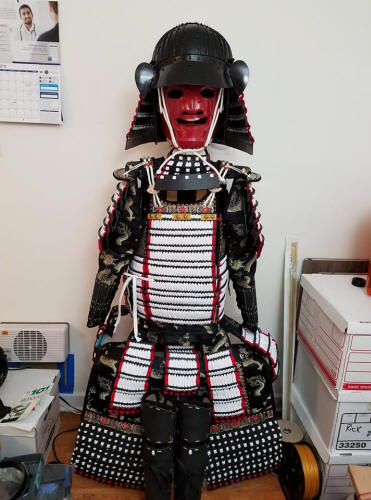 |
Haramaki-do As shown, 16 Plate Kabuto with under shikoro and Komanju-jikoro and bargrill (padding and ties not included); Sugake Odoshi laced Haramaki-do with included Sei-ita; Sugake Odoshi lace Ko-sode; Shino-gote with exposed ABS elbows; Ita-haidate; and Shino-suneate. Kebiki Odoshi: $2500 Sugake Odoshi: $2250 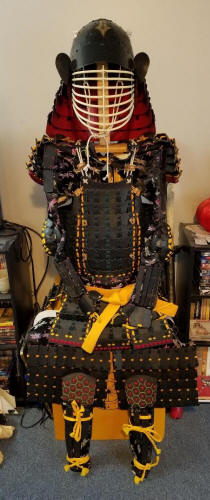 |
Sendai-do Full Suit Kebiki Odoshi: $ Sugake Odoshi: $ |
Dangae-do Full Suit $ |
Oyoroi Full Suit $ |
Youth Armor
All armors can be modified for Youth Combat. The standard Full Suit includes a modified Hockey Helmet with shikoro (to look more Japanese), Dou (body armor) of choice, Sode (shoulder armor), and Sueate (shin armor). All prices are for Sugake Odoshi (shown). For Kebiki Odoshi, add $50. All armor pieces are made from 1/8" ABS, but could be made from 1/8" HDPE (add $25 to the price). For upper Division Youth Fighters, the armor can be made from 3/16" ABS or HDPE (add $50 to the price).
Dou
どう
$175
Any Dou listed above, can be modified for Youth Combat. The examples below are of a Roku-mai Dou.
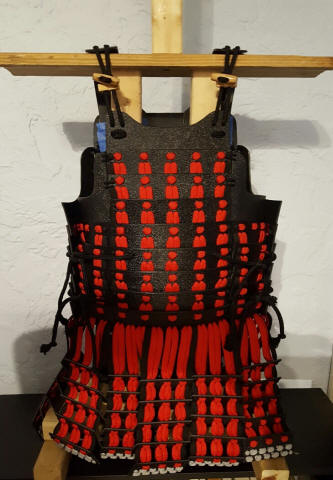
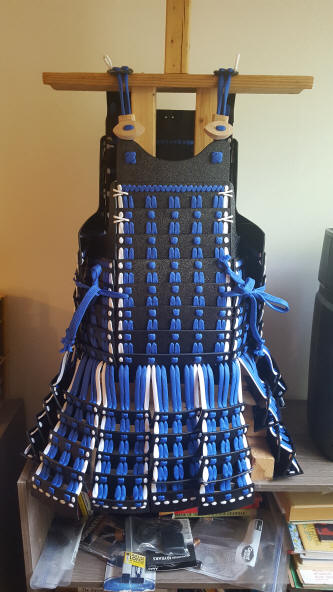
Kabuto
かぶと
$75 plus cost of Hockey Helmet
Modified Hockey Helmet to look more Japanese by adding shikoro.
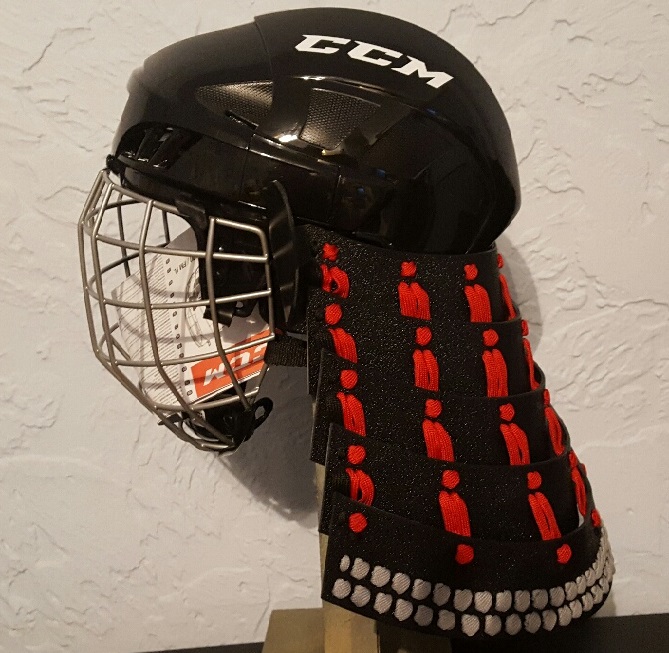
Sode
そで
$50
Any sode can be modified for youth combat. The example below is of a Chu-Sode.

Suneate
すねあて
$75
Any suneate can be modified for youth combat. The example, on the left, is of a Shino-suneate. The example, on the right, is of a Tsubo-suneate.
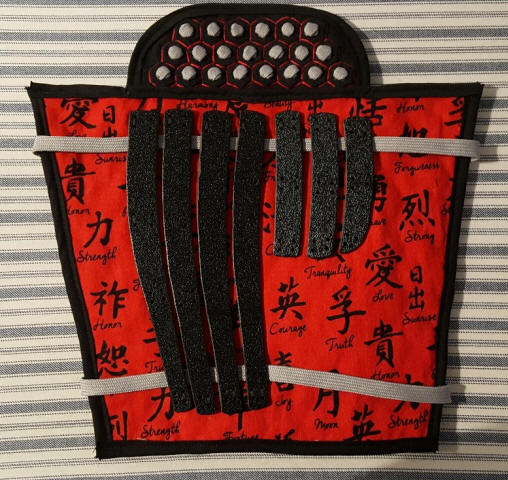
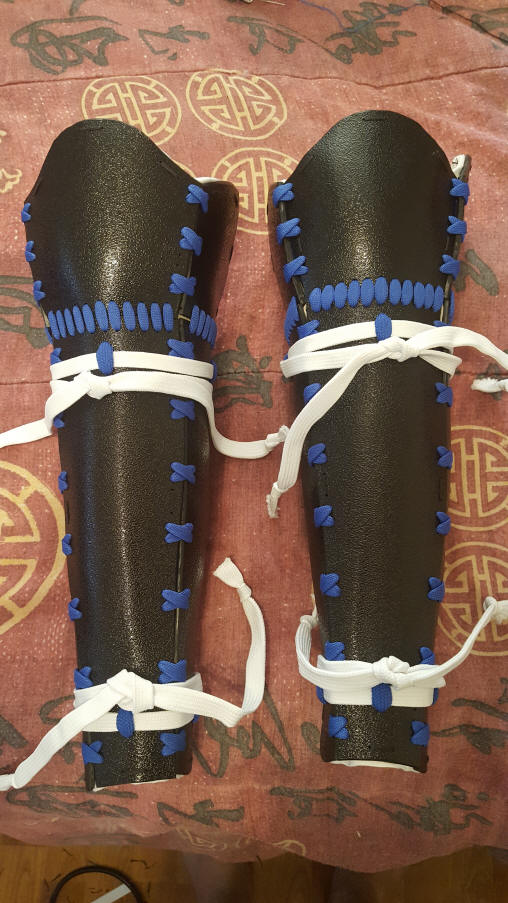
Accessories
Tate-eri
$75/set

Ordering Policy
References: